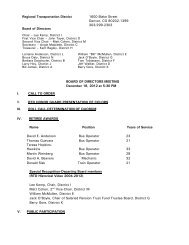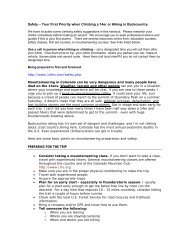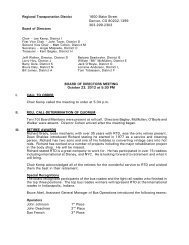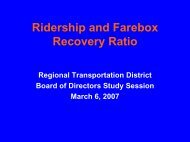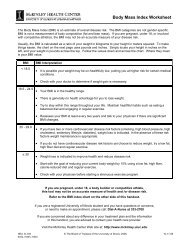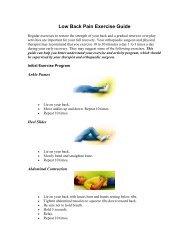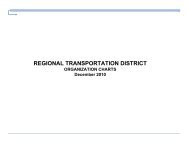Heartburn, Gastroesophageal Reflux (GER), and ... - RTD
Heartburn, Gastroesophageal Reflux (GER), and ... - RTD
Heartburn, Gastroesophageal Reflux (GER), and ... - RTD
Create successful ePaper yourself
Turn your PDF publications into a flip-book with our unique Google optimized e-Paper software.
<strong>Heartburn</strong>, <strong>Gastroesophageal</strong> <strong>Reflux</strong><br />
(<strong>GER</strong>), <strong>and</strong> <strong>Gastroesophageal</strong> <strong>Reflux</strong><br />
Disease (<strong>GER</strong>D)<br />
National Digestive Diseases Information Clearinghouse<br />
National<br />
Institute of<br />
Diabetes <strong>and</strong><br />
Digestive<br />
<strong>and</strong> Kidney<br />
Diseases<br />
NATIONAL<br />
INSTITUTES<br />
OF HEALTH<br />
What is <strong>GER</strong>D?<br />
<strong>Gastroesophageal</strong> reflux disease (<strong>GER</strong>D)<br />
is a more serious form of gastroesophageal<br />
reflux (<strong>GER</strong>), which is common. <strong>GER</strong><br />
occurs when the lower esophageal sphincter<br />
(LES) opens spontaneously, for varying<br />
periods of time, or does not close properly<br />
<strong>and</strong> stomach contents rise up into the<br />
esophagus. <strong>GER</strong> is also called acid reflux<br />
or acid regurgitation, because digestive<br />
juices—called acids—rise up with the food.<br />
The esophagus is the tube that carries food<br />
from the mouth to the stomach. The LES<br />
is a ring of muscle at the bottom of the<br />
esophagus that acts like a valve between<br />
the esophagus <strong>and</strong> stomach.<br />
When acid reflux occurs, food or fluid can<br />
be tasted in the back of the mouth. When<br />
refluxed stomach acid touches the lining of<br />
the esophagus it may cause a burning sensation<br />
in the chest or throat called heartburn<br />
or acid indigestion. Occasional <strong>GER</strong><br />
is common <strong>and</strong> does not necessarily mean<br />
one has <strong>GER</strong>D. Persistent reflux that<br />
occurs more than twice a week is considered<br />
<strong>GER</strong>D, <strong>and</strong> it can eventually lead to<br />
more serious health problems. People of<br />
all ages can have <strong>GER</strong>D.<br />
What are the symptoms of<br />
<strong>GER</strong>D?<br />
The main symptom of <strong>GER</strong>D in adults is<br />
frequent heartburn, also called acid indigestion—burning-type<br />
pain in the lower<br />
part of the mid-chest, behind the breast<br />
bone, <strong>and</strong> in the mid-abdomen. Most<br />
children under 12 years with <strong>GER</strong>D, <strong>and</strong><br />
some adults, have <strong>GER</strong>D without heartburn.<br />
Instead, they may experience a<br />
dry cough, asthma symptoms, or trouble<br />
swallowing.<br />
What causes <strong>GER</strong>D?<br />
The reason some people develop <strong>GER</strong>D is<br />
still unclear. However, research shows that<br />
in people with <strong>GER</strong>D, the LES relaxes<br />
while the rest of the esophagus is working.<br />
Anatomical abnormalities such as a hiatal<br />
hernia may also contribute to <strong>GER</strong>D. A<br />
hiatal hernia occurs when the upper part of<br />
the stomach <strong>and</strong> the LES move above the<br />
diaphragm, the muscle wall that separates<br />
the stomach from the chest. Normally, the<br />
diaphragm helps the LES keep acid from<br />
rising up into the esophagus. When a hiatal<br />
hernia is present, acid reflux can occur<br />
more easily. A hiatal hernia can occur in<br />
people of any age <strong>and</strong> is most often a normal<br />
finding in otherwise healthy people<br />
over age 50. Most of the time, a hiatal<br />
hernia produces no symptoms.<br />
U.S. Department<br />
of Health <strong>and</strong><br />
Human Services
Other factors that may contribute to <strong>GER</strong>D<br />
include<br />
• obesity<br />
• pregnancy<br />
• smoking<br />
Common foods that can worsen reflux<br />
symptoms include<br />
• citrus fruits<br />
• chocolate<br />
• drinks with caffeine or alcohol<br />
• fatty <strong>and</strong> fried foods<br />
• garlic <strong>and</strong> onions<br />
• mint flavorings<br />
• spicy foods<br />
• tomato-based foods, like spaghetti<br />
sauce, salsa, chili, <strong>and</strong> pizza<br />
What is <strong>GER</strong>D in children?<br />
Distinguishing between normal, physiologic<br />
reflux <strong>and</strong> <strong>GER</strong>D in children is<br />
important. Most infants with <strong>GER</strong> are<br />
happy <strong>and</strong> healthy even if they frequently<br />
spit up or vomit, <strong>and</strong> babies usually outgrow<br />
<strong>GER</strong> by their first birthday. <strong>Reflux</strong><br />
that continues past 1 year of age may be<br />
<strong>GER</strong>D. Studies show <strong>GER</strong>D is common<br />
<strong>and</strong> may be overlooked in infants <strong>and</strong><br />
children. For example, <strong>GER</strong>D can present<br />
as repeated regurgitation, nausea,<br />
heartburn, coughing, laryngitis, or<br />
respiratory problems like wheezing,<br />
asthma, or pneumonia. Infants <strong>and</strong><br />
young children may demonstrate irritability<br />
or arching of the back, often during or<br />
immediately after feedings. Infants with<br />
<strong>GER</strong>D may refuse to feed <strong>and</strong> experience<br />
poor growth.<br />
Talk with your child’s health care provider<br />
if reflux-related symptoms occur regularly<br />
<strong>and</strong> cause your child discomfort. Your<br />
health care provider may recommend<br />
simple strategies for avoiding reflux,<br />
such as burping the infant several times<br />
during feeding or keeping the infant in<br />
an upright position for 30 minutes after<br />
feeding. If your child is older, your health<br />
care provider may recommend that your<br />
child eat small, frequent meals <strong>and</strong> avoid<br />
the following foods:<br />
• sodas that contain caffeine<br />
• chocolate<br />
• peppermint<br />
• spicy foods<br />
• acidic foods like oranges, tomatoes,<br />
<strong>and</strong> pizza<br />
• fried <strong>and</strong> fatty foods<br />
Avoiding food 2 to 3 hours before bed<br />
may also help. Your health care provider<br />
may recommend raising the head of your<br />
child’s bed with wood blocks secured<br />
under the bedposts. Just using extra<br />
pillows will not help. If these changes<br />
do not work, your health care provider<br />
may prescribe medicine for your child.<br />
In rare cases, a child may need surgery.<br />
For information about <strong>GER</strong> in infants,<br />
children, <strong>and</strong> adolescents, see the<br />
<strong>Gastroesophageal</strong> <strong>Reflux</strong> in Infants <strong>and</strong><br />
<strong>Gastroesophageal</strong> <strong>Reflux</strong> in Children <strong>and</strong><br />
Adolescents fact sheets from the National<br />
Institute of Diabetes <strong>and</strong> Digestive <strong>and</strong><br />
Kidney Diseases (NIDDK).<br />
2 <strong>Heartburn</strong>, <strong>Gastroesophageal</strong> <strong>Reflux</strong> (<strong>GER</strong>), <strong>and</strong> <strong>Gastroesophageal</strong> <strong>Reflux</strong> Disease (<strong>GER</strong>D)
How is <strong>GER</strong>D treated?<br />
See your health care provider if you have<br />
had symptoms of <strong>GER</strong>D <strong>and</strong> have been<br />
using antacids or other over-the-counter<br />
reflux medications for more than 2 weeks.<br />
Your health care provider may refer you to<br />
a gastroenterologist, a doctor who treats<br />
diseases of the stomach <strong>and</strong> intestines.<br />
Depending on the severity of your <strong>GER</strong>D,<br />
treatment may involve one or more of the<br />
following lifestyle changes, medications,<br />
or surgery.<br />
Lifestyle Changes<br />
• If you smoke, stop.<br />
• Avoid foods <strong>and</strong> beverages that<br />
worsen symptoms.<br />
• Lose weight if needed.<br />
• Eat small, frequent meals.<br />
• Wear loose-fitting clothes.<br />
• Avoid lying down for 3 hours after<br />
a meal.<br />
• Raise the head of your bed 6 to<br />
8 inches by securing wood blocks<br />
under the bedposts. Just using<br />
extra pillows will not help.<br />
Medications<br />
Your health care provider may recommend<br />
over-the-counter antacids or medications<br />
that stop acid production or help the<br />
muscles that empty your stomach. You can<br />
buy many of these medications without a<br />
prescription. However, see your health<br />
care provider before starting or adding<br />
a medication.<br />
Antacids, such as Alka-Seltzer, Maalox,<br />
Mylanta, Rolaids, <strong>and</strong> Riopan, are usually<br />
the first drugs recommended to relieve<br />
heartburn <strong>and</strong> other mild <strong>GER</strong>D symptoms.<br />
Many br<strong>and</strong>s on the market use<br />
different combinations of three basic salts—<br />
magnesium, calcium, <strong>and</strong> aluminum—with<br />
hydroxide or bicarbonate ions to neutralize<br />
the acid in your stomach. Antacids, however,<br />
can have side effects. Magnesium salt<br />
can lead to diarrhea, <strong>and</strong> aluminum salt<br />
may cause constipation. Aluminum <strong>and</strong><br />
magnesium salts are often combined in a<br />
single product to balance these effects.<br />
Calcium carbonate antacids, such as Tums,<br />
Titralac, <strong>and</strong> Alka-2, can also be a supplemental<br />
source of calcium. They can cause<br />
constipation as well.<br />
Foaming agents, such as Gaviscon, work by<br />
covering your stomach contents with foam<br />
to prevent reflux.<br />
H2 blockers, such as cimetidine (Tagamet<br />
HB), famotidine (Pepcid AC), nizatidine<br />
(Axid AR), <strong>and</strong> ranitidine (Zantac 75),<br />
decrease acid production. They are available<br />
in prescription strength <strong>and</strong> over-thecounter<br />
strength. These drugs provide<br />
short-term relief <strong>and</strong> are effective for about<br />
half of those who have <strong>GER</strong>D symptoms.<br />
Proton pump inhibitors include omeprazole<br />
(Prilosec, Zegerid), lansoprazole<br />
(Prevacid), pantoprazole (Protonix),<br />
rabeprazole (Aciphex), <strong>and</strong> esomeprazole<br />
(Nexium), which are available by prescription.<br />
Prilosec is also available in over-thecounter<br />
strength. Proton pump inhibitors<br />
are more effective than H2 blockers <strong>and</strong> can<br />
relieve symptoms <strong>and</strong> heal the esophageal<br />
lining in almost everyone who has <strong>GER</strong>D.<br />
Prokinetics help strengthen the LES <strong>and</strong><br />
make the stomach empty faster. This group<br />
includes bethanechol (Urecholine) <strong>and</strong><br />
metoclopramide (Reglan). Metoclopramide<br />
also improves muscle action in the<br />
digestive tract. Prokinetics have frequent<br />
side effects that limit their usefulness—<br />
fatigue, sleepiness, depression, anxiety,<br />
<strong>and</strong> problems with physical movement.<br />
3 <strong>Heartburn</strong>, <strong>Gastroesophageal</strong> <strong>Reflux</strong> (<strong>GER</strong>), <strong>and</strong> <strong>Gastroesophageal</strong> <strong>Reflux</strong> Disease (<strong>GER</strong>D)
Because drugs work in different ways, combinations<br />
of medications may help control<br />
symptoms. People who get heartburn after<br />
eating may take both antacids <strong>and</strong> H2<br />
blockers. The antacids work first to neutralize<br />
the acid in the stomach, <strong>and</strong> then<br />
the H2 blockers act on acid production.<br />
By the time the antacid stops working, the<br />
H2 blocker will have stopped acid production.<br />
Your health care provider is the best<br />
source of information about how to use<br />
medications for <strong>GER</strong>D.<br />
What if <strong>GER</strong>D symptoms<br />
persist?<br />
If your symptoms do not improve with<br />
lifestyle changes or medications, you may<br />
need additional tests.<br />
• Barium swallow radiograph uses<br />
x rays to help spot abnormalities such<br />
as a hiatal hernia <strong>and</strong> other structural<br />
or anatomical problems of the esophagus.<br />
With this test, you drink a solution<br />
<strong>and</strong> then x rays are taken. The<br />
test will not detect mild irritation,<br />
although strictures—narrowing of<br />
the esophagus—<strong>and</strong> ulcers can be<br />
observed.<br />
• Upper endoscopy is more accurate<br />
than a barium swallow radiograph <strong>and</strong><br />
may be performed in a hospital or a<br />
doctor’s office. The doctor may spray<br />
your throat to numb it <strong>and</strong> then, after<br />
lightly sedating you, will slide a thin,<br />
flexible plastic tube with a light <strong>and</strong><br />
lens on the end called an endoscope<br />
down your throat. Acting as a tiny<br />
camera, the endoscope allows the doctor<br />
to see the surface of the esophagus<br />
<strong>and</strong> search for abnormalities. If you<br />
have had moderate to severe symptoms<br />
<strong>and</strong> this procedure reveals injury<br />
to the esophagus, usually no other<br />
tests are needed to confirm <strong>GER</strong>D.<br />
The doctor also may perform a biopsy.<br />
Tiny tweezers, called forceps, are<br />
passed through the endoscope <strong>and</strong><br />
allow the doctor to remove small<br />
pieces of tissue from your esophagus.<br />
The tissue is then viewed with a microscope<br />
to look for damage caused by<br />
acid reflux <strong>and</strong> to rule out other problems<br />
if infection or abnormal growths<br />
are not found.<br />
• pH monitoring examination involves<br />
the doctor either inserting a small tube<br />
into the esophagus or clipping a tiny<br />
device to the esophagus that will stay<br />
there for 24 to 48 hours. While you<br />
go about your normal activities, the<br />
device measures when <strong>and</strong> how much<br />
acid comes up into your esophagus.<br />
This test can be useful if combined<br />
with a carefully completed diary—<br />
recording when, what, <strong>and</strong> amounts<br />
the person eats—which allows the<br />
doctor to see correlations between<br />
symptoms <strong>and</strong> reflux episodes. The<br />
procedure is sometimes helpful in<br />
detecting whether respiratory symptoms,<br />
including wheezing <strong>and</strong> coughing,<br />
are triggered by reflux.<br />
A completely accurate diagnostic test for<br />
<strong>GER</strong>D does not exist, <strong>and</strong> tests have not<br />
consistently shown that acid exposure to<br />
the lower esophagus directly correlates<br />
with damage to the lining.<br />
Surgery<br />
Surgery is an option when medicine <strong>and</strong><br />
lifestyle changes do not help to manage<br />
<strong>GER</strong>D symptoms. Surgery may also be<br />
a reasonable alternative to a lifetime of<br />
drugs <strong>and</strong> discomfort.<br />
4 <strong>Heartburn</strong>, <strong>Gastroesophageal</strong> <strong>Reflux</strong> (<strong>GER</strong>), <strong>and</strong> <strong>Gastroesophageal</strong> <strong>Reflux</strong> Disease (<strong>GER</strong>D)
Fundoplication is the st<strong>and</strong>ard surgical<br />
treatment for <strong>GER</strong>D. Usually a specific<br />
type of this procedure, called Nissen fundoplication,<br />
is performed. During the Nissen<br />
fundoplication, the upper part of the<br />
stomach is wrapped around the LES to<br />
strengthen the sphincter, prevent acid<br />
reflux, <strong>and</strong> repair a hiatal hernia.<br />
The Nissen fundoplication may be performed<br />
using a laparoscope, an instrument<br />
that is inserted through tiny incisions in<br />
the abdomen. The doctor then uses small<br />
instruments that hold a camera to look at<br />
the abdomen <strong>and</strong> pelvis. When performed<br />
by experienced surgeons, laparoscopic fundoplication<br />
is safe <strong>and</strong> effective in people<br />
of all ages, including infants. The procedure<br />
is reported to have the same results<br />
as the st<strong>and</strong>ard fundoplication, <strong>and</strong> people<br />
can leave the hospital in 1 to 3 days <strong>and</strong><br />
return to work in 2 to 3 weeks.<br />
Endoscopic techniques used to treat<br />
chronic heartburn include the Bard<br />
EndoCinch system, NDO Plicator, <strong>and</strong> the<br />
Stretta system. These techniques require<br />
the use of an endoscope to perform the<br />
anti-reflux operation. The EndoCinch<br />
<strong>and</strong> NDO Plicator systems involve putting<br />
stitches in the LES to create pleats that<br />
help strengthen the muscle. The Stretta<br />
system uses electrodes to create tiny burns<br />
on the LES. When the burns heal, the scar<br />
tissue helps toughen the muscle. The longterm<br />
effects of these three procedures are<br />
unknown.<br />
What are the long-term<br />
complications of <strong>GER</strong>D?<br />
Chronic <strong>GER</strong>D that is untreated can cause<br />
serious complications. Inflammation of the<br />
esophagus from refluxed stomach acid can<br />
damage the lining <strong>and</strong> cause bleeding or<br />
ulcers—also called esophagitis. Scars<br />
from tissue damage can lead to strictures—<br />
narrowing of the esophagus—that make<br />
swallowing difficult. Some people develop<br />
Barrett’s esophagus, in which cells in the<br />
esophageal lining take on an abnormal<br />
shape <strong>and</strong> color. Over time, the cells can<br />
lead to esophageal cancer, which is often<br />
fatal. Persons with <strong>GER</strong>D <strong>and</strong> its complications<br />
should be monitored closely by a<br />
physician.<br />
Studies have shown that <strong>GER</strong>D may<br />
worsen or contribute to asthma, chronic<br />
cough, <strong>and</strong> pulmonary fibrosis.<br />
For information about Barrett’s esophagus,<br />
see the Barrett’s Esophagus fact sheet from<br />
the NIDDK.<br />
5 <strong>Heartburn</strong>, <strong>Gastroesophageal</strong> <strong>Reflux</strong> (<strong>GER</strong>), <strong>and</strong> <strong>Gastroesophageal</strong> <strong>Reflux</strong> Disease (<strong>GER</strong>D)
Points to Remember<br />
• Frequent heartburn, also called acid<br />
indigestion, is the most common<br />
symptom of <strong>GER</strong>D in adults. Anyone<br />
experiencing heartburn twice a week<br />
or more may have <strong>GER</strong>D.<br />
• You can have <strong>GER</strong>D without having<br />
heartburn. Your symptoms could<br />
include a dry cough, asthma symptoms,<br />
or trouble swallowing.<br />
• If you have been using antacids for<br />
more than 2 weeks, it is time to see<br />
your health care provider. Most doctors<br />
can treat <strong>GER</strong>D. Your health<br />
care provider may refer you to a gastroenterologist,<br />
a doctor who treats<br />
diseases of the stomach <strong>and</strong> intestines.<br />
• Health care providers usually recommend<br />
lifestyle <strong>and</strong> dietary changes to<br />
relieve symptoms of <strong>GER</strong>D. Many<br />
people with <strong>GER</strong>D also need medication.<br />
Surgery may be considered as a<br />
treatment option.<br />
• Most infants with <strong>GER</strong> are healthy<br />
even though they may frequently spit<br />
up or vomit. Most infants outgrow<br />
<strong>GER</strong> by their first birthday. <strong>Reflux</strong><br />
that continues past 1 year of age may<br />
be <strong>GER</strong>D.<br />
• The persistence of <strong>GER</strong> along with<br />
other symptoms—arching <strong>and</strong> irritability<br />
in infants, or abdominal <strong>and</strong> chest<br />
pain in older children—is <strong>GER</strong>D.<br />
<strong>GER</strong>D is the outcome of frequent <strong>and</strong><br />
persistent <strong>GER</strong> in infants <strong>and</strong> children<br />
<strong>and</strong> may cause repeated vomiting,<br />
coughing, <strong>and</strong> respiratory problems.<br />
Hope Through Research<br />
The reasons certain people develop<br />
<strong>GER</strong>D <strong>and</strong> others do not remain<br />
unknown. Several factors may be<br />
involved, <strong>and</strong> research is under way to<br />
explore risk factors for developing<br />
<strong>GER</strong>D <strong>and</strong> the role of <strong>GER</strong>D in other<br />
conditions such as asthma <strong>and</strong><br />
laryngitis.<br />
6 <strong>Heartburn</strong>, <strong>Gastroesophageal</strong> <strong>Reflux</strong> (<strong>GER</strong>), <strong>and</strong> <strong>Gastroesophageal</strong> <strong>Reflux</strong> Disease (<strong>GER</strong>D)
For More Information<br />
American College of Gastroenterology<br />
P.O. Box 342260<br />
Bethesda, MD 20827–2260<br />
Phone: 301–263–9000<br />
Internet: www.acg.gi.org<br />
American Gastroenterological Association<br />
National Office<br />
4930 Del Ray Avenue<br />
Bethesda, MD 20814<br />
Phone: 301–654–2055<br />
Fax: 301–654–5920<br />
Email: member@gastro.org<br />
Internet: www.gastro.org<br />
International Foundation for Functional<br />
Gastrointestinal Disorders<br />
P.O. Box 170864<br />
Milwaukee, WI 53217–8076<br />
Phone: 1–888–964–2001 or 414–964–1799<br />
Fax: 414–964–7176<br />
Email: iffgd@iffgd.org<br />
Internet: www.aboutgerd.org<br />
You may also find additional information on this topic<br />
using the following databases:<br />
The NIDDK Reference Collection is a collection<br />
of thous<strong>and</strong>s of materials produced for patients <strong>and</strong><br />
health care professionals, including fact sheets,<br />
brochures, <strong>and</strong> audiovisual materials. Visit<br />
www.catalog.niddk.nih.gov/resources.<br />
MedlinePlus brings together a wealth of information<br />
from the National Library of Medicine, the National<br />
Institutes of Health, <strong>and</strong> other government agencies<br />
<strong>and</strong> health-related organizations. MedlinePlus offers<br />
easy access to medical journal articles, a medical dictionary<br />
<strong>and</strong> medical encyclopedia, health information<br />
in Spanish, hospital <strong>and</strong> physician directories, drug<br />
<strong>and</strong> supplement lists, interactive patient tutorials,<br />
links to hundreds of clinical trials, <strong>and</strong> the latest<br />
health news. Visit www.medlineplus.gov.<br />
The U.S. Government does not endorse or favor any<br />
specific commercial product or company. Trade,<br />
proprietary, or company names appearing in this<br />
document are used only because they are considered<br />
necessary in the context of the information provided.<br />
If a product is not mentioned, the omission does not<br />
mean or imply that the product is unsatisfactory.<br />
North American Society for Pediatric<br />
Gastroenterology, Hepatology, <strong>and</strong><br />
Nutrition<br />
P.O. Box 6<br />
Flourtown, PA 19031<br />
Phone: 215–233–0808<br />
Fax: 215–233–3918<br />
Email: naspghan@naspghan.org<br />
Internet: www.naspghan.org<br />
Pediatric/Adolescent <strong>Gastroesophageal</strong><br />
<strong>Reflux</strong> Association, Inc.<br />
P.O. Box 486<br />
Buckeystown, MD 21717–0486<br />
Phone: 301–601–9541<br />
Email: gergroup@aol.com<br />
Internet: www.reflux.org<br />
7 <strong>Heartburn</strong>, <strong>Gastroesophageal</strong> <strong>Reflux</strong> (<strong>GER</strong>), <strong>and</strong> <strong>Gastroesophageal</strong> <strong>Reflux</strong> Disease (<strong>GER</strong>D)
National Digestive Diseases<br />
Information Clearinghouse<br />
2 Information Way<br />
Bethesda, MD 20892–3570<br />
Phone: 1–800–891–5389<br />
Fax: 703–738–4929<br />
Email: nddic@info.niddk.nih.gov<br />
Internet: www.digestive.niddk.nih.gov<br />
The National Digestive Diseases Information<br />
Clearinghouse (NDDIC) is a service of the<br />
National Institute of Diabetes <strong>and</strong> Digestive <strong>and</strong><br />
Kidney Diseases (NIDDK). The NIDDK is<br />
part of the National Institutes of Health of<br />
the U.S. Department of Health <strong>and</strong> Human<br />
Services. Established in 1980, the Clearinghouse<br />
provides information about digestive<br />
diseases to people with digestive disorders <strong>and</strong><br />
to their families, health care professionals, <strong>and</strong><br />
the public. The NDDIC answers inquiries,<br />
develops <strong>and</strong> distributes publications, <strong>and</strong><br />
works closely with professional <strong>and</strong> patient<br />
organizations <strong>and</strong> Government agencies to<br />
coordinate resources about digestive diseases.<br />
Publications produced by the Clearinghouse are<br />
carefully reviewed by both NIDDK scientists<br />
<strong>and</strong> outside experts. This fact sheet was<br />
reviewed by M. Brian Fennerty, M.D., Oregon<br />
Health <strong>and</strong> Science University, <strong>and</strong> Benjamin<br />
D. Gold, M.D., Emory University School of<br />
Medicine.<br />
This publication is not copyrighted. The<br />
Clearinghouse encourages users of this fact<br />
sheet to duplicate <strong>and</strong> distribute as many<br />
copies as desired.<br />
This fact sheet is also available at<br />
www.digestive.niddk.nih.gov.<br />
U.S. DEPARTMENT OF HEALTH<br />
AND HUMAN SERVICES<br />
National Institutes of Health<br />
NIH Publication No. 07–0882<br />
May 2007
NatioNal Digestive Diseases iNformatioN CleariNghouse (NDDiC)<br />
Irritable Bowel Syndrome<br />
What You Need to Know<br />
C figure - PMS 2705<br />
79<br />
69<br />
0<br />
0<br />
NDIC logo - PMS 2725<br />
C = 43<br />
M = 34<br />
Y = 0<br />
K = 0<br />
Did you know that if you often<br />
have stomach cramps, bloating,<br />
gas, diarrhea, or constipation,<br />
you could have irritable bowel<br />
syndrome?<br />
What is irritable bowel syndrome?<br />
Irritable bowel syndrome (IBS) is a<br />
functional disorder of the large bowel,<br />
meaning the bowel doesn’t work, or function,<br />
correctly. IBS is not a disease, but a group<br />
of symptoms.<br />
What are the symptoms of IBS?<br />
The main symptoms of IBS are<br />
• pain or discomfort in the abdomen, often<br />
relieved by a bowel movement<br />
• chronic diarrhea, constipation, or both<br />
Other symptoms include<br />
• whitish mucus in the stool<br />
• a swollen or bloated abdomen<br />
• the feeling that you have not finished a<br />
bowel movement<br />
Women with IBS often have more symptoms<br />
during their menstrual periods.<br />
How will I know if I have IBS?<br />
Your doctor may diagnose IBS based on<br />
your symptoms. No specific test for IBS<br />
exists, but your doctor may do some tests<br />
to rule out other health problems that can<br />
cause the same symptoms.<br />
What can I do about IBS?<br />
IBS has no cure but you can take some steps<br />
to relieve symptoms. You might have to try<br />
a few different things to see what works best<br />
for you. Your doctor can help you find the<br />
right treatment plan, which may include<br />
• avoiding foods that can trigger symptoms,<br />
such as fatty foods, milk products, <strong>and</strong><br />
carbonated drinks<br />
• eating foods with fiber<br />
• eating four or five small meals instead of<br />
three big meals<br />
• taking medicines that help relieve<br />
symptoms<br />
• reducing emotional stress
NatioNal Digestive Diseases iNformatioN CleariNghouse (NDDiC)<br />
Where can I get more information<br />
about IBS?<br />
National Digestive Diseases<br />
Information Clearinghouse<br />
2 Information Way<br />
Bethesda, MD 20892–3570<br />
Phone: 1–800–891–5389<br />
Fax: 703–738–4929<br />
Email: nddic@info.niddk.nih.gov<br />
Internet: www.digestive.niddk.nih.gov<br />
The National Digestive Diseases Information<br />
Clearinghouse is a service of the National<br />
Institute of Diabetes <strong>and</strong> Digestive <strong>and</strong><br />
Kidney Diseases (NIDDK). The NIDDK is<br />
part of the National Institutes of Health of<br />
the U.S. Department of Health <strong>and</strong> Human<br />
Services.<br />
This publication is not copyrighted. The<br />
Clearinghouse encourages people to duplicate<br />
<strong>and</strong> distribute as many copies as desired.<br />
The NIDDK Awareness <strong>and</strong> Prevention Series is<br />
designed to make you ask yourself, “Could this be<br />
me or someone I care for?” So take a closer look.<br />
Additional information on this topic <strong>and</strong> other<br />
titles in the series is available through the National<br />
Digestive Diseases Information Clearinghouse or<br />
on the Internet at www.digestive.niddk.nih.gov.<br />
U.S. DEPARTMENT OF HEALTH<br />
AND HUMAN SERVICES<br />
National Institutes of Health<br />
NIH Publication No. 07–6189<br />
August 2007
NatioNal Digestive Diseases iNformatioN CleariNghouse (NDDiC)<br />
Lactose Intolerance<br />
What You Need to Know<br />
C figure - PMS 2705<br />
79<br />
69<br />
0<br />
0<br />
NDIC logo - PMS 2725<br />
C = 43<br />
M = 34<br />
Y = 0<br />
K = 0<br />
Did you know that if you feel<br />
sick after drinking milk or eating<br />
foods made with milk, you may<br />
have lactose intolerance?<br />
What is lactose intolerance?<br />
Lactose intolerance means you cannot digest<br />
foods with lactose in them. Lactose is the<br />
sugar found in milk <strong>and</strong> foods made with<br />
milk. Lactose intolerance is not serious, but<br />
it can make you very uncomfortable after<br />
you eat foods with lactose.<br />
How will I feel if I have lactose<br />
intolerance?<br />
After eating foods with lactose in them, you<br />
may feel sick to your stomach. You may also<br />
have cramps, bloating, gas, or diarrhea.<br />
Some illnesses can cause these same<br />
problems. Your doctor can do tests to<br />
see if your problems are caused by lactose<br />
intolerance or by something else.<br />
What can I do about lactose<br />
intolerance?<br />
You will need to avoid or eat less of foods<br />
that have lactose in them.<br />
Lactose is in milk <strong>and</strong> all foods made<br />
with milk. It is also added to some boxed,<br />
canned, frozen, <strong>and</strong> other prepared foods,<br />
such as<br />
• breads<br />
• cereals<br />
• lunch meats<br />
• salad dressings<br />
• mixes for cakes, cookies, pancakes, <strong>and</strong><br />
biscuits<br />
• frozen dinners<br />
Learn to read food labels carefully.<br />
Look for milk <strong>and</strong> lactose in the list of<br />
ingredients. Also look for words like whey,<br />
curds, milk by-products, dried milk, milk<br />
solids, <strong>and</strong> powdered milk. If any of these<br />
words are listed on a label, the product<br />
contains lactose.<br />
Do I have to avoid all foods with<br />
lactose?<br />
Not necessarily. You may be able to eat a<br />
small amount of some foods with lactose.<br />
For example, you may be able to eat cheese<br />
or yogurt but not drink milk. Try a small<br />
amount of the food <strong>and</strong> then see how you<br />
feel. You can also drink lactose-reduced<br />
milk. And you can buy lactase enzyme<br />
caplets or drops that help you digest lactose.
NatioNal Digestive Diseases iNformatioN CleariNghouse (NDDiC)<br />
Where can I get more information<br />
about lactose intolerance?<br />
National Digestive Diseases<br />
Information Clearinghouse<br />
2 Information Way<br />
Bethesda, MD 20892–3570<br />
Phone: 1–800–891–5389<br />
Fax: 703–738–4929<br />
Email: nddic@info.niddk.nih.gov<br />
Internet: www.digestive.niddk.nih.gov<br />
The National Digestive Diseases Information<br />
Clearinghouse is a service of the National<br />
Institute of Diabetes <strong>and</strong> Digestive <strong>and</strong><br />
Kidney Diseases (NIDDK). The NIDDK is<br />
part of the National Institutes of Health of<br />
the U.S. Department of Health <strong>and</strong> Human<br />
Services.<br />
This publication is not copyrighted. The<br />
Clearinghouse encourages people to duplicate<br />
<strong>and</strong> distribute as many copies as desired.<br />
The NIDDK Awareness <strong>and</strong> Prevention Series is<br />
designed to make you ask yourself, “Could this be<br />
me or someone I care for?” So take a closer look.<br />
Additional information on this topic <strong>and</strong> other<br />
titles in the series is available through the National<br />
Digestive Diseases Information Clearinghouse or<br />
on the Internet at www.digestive.niddk.nih.gov.<br />
U.S. DEPARTMENT OF HEALTH<br />
AND HUMAN SERVICES<br />
National Institutes of Health<br />
NIH Publication No. 07–6187<br />
June 2007
TIPS FOR ADULTS<br />
Healthy Eating & Physical<br />
Activity Across Your Lifespan<br />
Better Health <strong>and</strong> You<br />
WIN<br />
Weight-control<br />
Information Network
To request additional brochures, contact the<br />
Weight-control Information Network at:<br />
1 WIN Way<br />
Bethesda, MD 20892–3665<br />
Phone: (202) 828–1025<br />
FAX: (202) 828–1028<br />
Toll-free number: 1–877–946–4627<br />
Email: WIN@info.niddk.nih.gov<br />
Internet: http://www.win.niddk.nih.gov<br />
Internet: http://www.win.niddk.nih.gov
Healthy Eating &<br />
Physical Activity<br />
Across Your Lifespan<br />
Better Health <strong>and</strong> You<br />
❑ Eat breakfast every day. People who eat<br />
breakfast are less likely to overeat later<br />
in the day.<br />
❑ Choose whole grains more often. Try whole-wheat<br />
breads <strong>and</strong> pastas, oatmeal, brown rice, or bulgur.<br />
❑ Select a mix of colorful vegetables each day. Vegetables of<br />
different colors provide different nutrients.<br />
❑ Eat three meals every day instead of skipping meals<br />
or eating a snack instead of a meal.<br />
❑ Have low-fat, low-sugar snacks on h<strong>and</strong> at home, at work,<br />
or on the go to combat hunger <strong>and</strong> prevent overeating.<br />
❑ At restaurants, eat only half your meal <strong>and</strong> take the<br />
rest home.<br />
❑ Visit museums, the zoo, or an aquarium. You <strong>and</strong> your<br />
family can walk for hours <strong>and</strong> not realize it.<br />
❑ Take a walk after dinner instead of watching TV.<br />
❑ Get plenty of sleep.<br />
WIN<br />
Weight-control Information Network
Index<br />
Introduction......................................... 1<br />
Healthy Eating<br />
What is a healthy eating plan? .......................... 2<br />
Tips for Healthy Eating ................................ 2<br />
Quick Breakfast Ideas................................. 4<br />
Easy Snack Ideas .................................... 5<br />
Healthy Weight<br />
What is a healthy weight?.............................. 6<br />
What are the health risks of being overweight? ............. 7<br />
Why do people become overweight?..................... 8<br />
If You Need to Lose Weight ........................... 10<br />
Physical Activity<br />
Getting Active...................................... 12<br />
Are you ready to be even more active?. ................. 13<br />
Be Good to Yourself ................................. 16<br />
Tips for Adults...................................... 17<br />
Additional Reading .................................. 18<br />
Additional Resources ................................ 19<br />
Better Health <strong>and</strong> You
Introduction<br />
A balanced eating plan <strong>and</strong> regular physical activity are<br />
the building blocks of good health. Poor eating habits<br />
<strong>and</strong> physical inactivity may lead to overweight <strong>and</strong> related<br />
health problems. By eating right <strong>and</strong> being active, you<br />
may reach or maintain a healthy weight. You may also<br />
improve your physical health, mental well-being, <strong>and</strong> set<br />
an example for others.<br />
Do it for yourself <strong>and</strong> your family!<br />
Better Health <strong>and</strong> You<br />
1
Healthy Eating<br />
What is a healthy eating plan?<br />
A healthy eating plan:<br />
• Emphasizes fruits, vegetables, whole grains,<br />
<strong>and</strong> fat-free or low-fat milk <strong>and</strong> milk products.<br />
• Includes lean meats, poultry, fish, beans,<br />
eggs, <strong>and</strong> nuts.<br />
• Is low in saturated fats, trans fats, cholesterol,<br />
salt (sodium), <strong>and</strong> added sugars.<br />
For more specific information about food groups <strong>and</strong><br />
nutrition values, visit http://www.healthierus.gov/dietaryguidelines.<br />
Tips for Healthy Eating<br />
• Eat breakfast every day. People who eat breakfast are less<br />
likely to overeat later in the day. Breakfast also gives you<br />
energy <strong>and</strong> helps you get your day off to a healthy start.<br />
• Choose whole grains more often. Try whole-wheat breads<br />
<strong>and</strong> pastas, oatmeal, brown rice, or bulgur.<br />
• Select a mix of colorful vegetables each day. Vegetables<br />
of different colors provide different nutrients. Choose dark<br />
leafy greens such as spinach, kale, collards, <strong>and</strong> mustard<br />
greens, <strong>and</strong> reds <strong>and</strong> oranges such as carrots, sweet<br />
potatoes, red peppers, <strong>and</strong> tomatoes.<br />
2 Better Health <strong>and</strong> You
Healthy Eating<br />
• Choose fresh, canned, or frozen fruit more often than<br />
fruit juice. Fruit juice has little or no fiber, <strong>and</strong> the calories<br />
may be high. Fresh, canned, or frozen fruit is often better<br />
for you. If you eat canned fruit, opt for fruit packed in water<br />
rather than syrup.<br />
• Use fats <strong>and</strong> oils sparingly. Olive, canola, <strong>and</strong> peanut oils,<br />
avocados, nuts <strong>and</strong> nut butters, olives, <strong>and</strong> fish provide<br />
heart-healthy fat as well as vitamins <strong>and</strong> minerals.<br />
• Eat sweets sparingly. Limit foods <strong>and</strong> beverages that are<br />
high in added sugars.<br />
• Eat three meals every day. If you skip meals or replace<br />
a meal with a snack, you might overeat later on.<br />
• Have low-fat, low-sugar snacks on h<strong>and</strong>.<br />
Whether you are at home, at work, or<br />
on the go, healthy snacks may help to<br />
combat hunger <strong>and</strong> prevent overeating.<br />
Better Health <strong>and</strong> You<br />
3
Healthy Eating<br />
Quick Breakfast Ideas<br />
• low-fat yogurt sprinkled with<br />
low-fat granola<br />
• oatmeal with low-fat or fat-free<br />
milk, or soy-based beverage<br />
• a slice of whole-wheat toast with<br />
a thin spread of peanut butter<br />
• fruit smoothie made with frozen<br />
fruit, low-fat yogurt, <strong>and</strong> juice<br />
• high-fiber, low-sugar cereal with<br />
soy-based beverage or low-fat<br />
milk<br />
4 Better Health <strong>and</strong> You
Healthy Eating<br />
Easy Snack Ideas<br />
• low-fat or fat-free yogurt<br />
• rice cakes<br />
• fresh or canned fruits<br />
• sliced vegetables or baby carrots<br />
• dried fruit <strong>and</strong> nut mix (no more<br />
than a small h<strong>and</strong>ful)<br />
• air-popped popcorn sprinkled with<br />
garlic powder or other spices<br />
• high-fiber, low-sugar cereal<br />
Better Health <strong>and</strong> You<br />
5
Healthy Weight<br />
What is a healthy weight?<br />
Body mass index (BMI) is one way to tell whether you are at a<br />
healthy weight, overweight, or obese. It measures your weight in<br />
relation to your height.<br />
A BMI of 18.5 to 24.9 is in the healthy range. A BMI of 25 to 29.9 is<br />
overweight, <strong>and</strong> a BMI of 30 or greater is considered obese.<br />
In the chart below, find your height in the left-h<strong>and</strong> column <strong>and</strong> move<br />
across the row to find your weight. If you are in the overweight or obese<br />
range on the chart, you may be at risk for certain health problems.<br />
BMI (Body Mass Index)<br />
Sources<br />
■ George Bray, M.D.,<br />
Pennington Biomedical<br />
Research Center.<br />
■ National Heart, Lung,<br />
<strong>and</strong> Blood Institute’s<br />
Clinical Guidelines<br />
on the Identification,<br />
Evaluation, <strong>and</strong><br />
Treatment of<br />
Overweight <strong>and</strong><br />
Obesity in Adults:<br />
The Evidence Report.<br />
Weight in Pounds **<br />
* Without Shoes **Without Clothes<br />
6 Better Health <strong>and</strong> You
Healthy Weight<br />
Another way to find out if you are at risk for health problems caused<br />
by overweight <strong>and</strong> obesity is to measure your waist. If you are a<br />
woman <strong>and</strong> your waist is more than 35 inches, or if you are a man<br />
<strong>and</strong> your waist is more than 40 inches, your risk of disease is higher.<br />
What are the health risks<br />
of being overweight?<br />
Extra weight may put you at higher risk for:<br />
• type 2 diabetes (high blood sugar)<br />
• high blood pressure<br />
• coronary heart disease <strong>and</strong> stroke<br />
• some types of cancer<br />
• sleep apnea (when breathing stops for<br />
short periods during sleep)<br />
• osteoarthritis (wearing away of the joints)<br />
• gallbladder disease<br />
• irregular periods<br />
• problems with pregnancy, such as<br />
gestational diabetes (high blood sugar<br />
during pregnancy), high blood pressure,<br />
or increased risk for cesarean section<br />
(c-section)<br />
Better Health <strong>and</strong> You<br />
7
Healthy Weight<br />
Why do people become overweight?<br />
Many factors may play a part in why people gain weight.<br />
• Habits. Eating too many calories may become a habit. You may<br />
also develop a habit of doing sedentary activities like watching<br />
TV instead of being physically active. Over time, these habits can<br />
lead to weight gain.<br />
• Genes. Overweight <strong>and</strong> obesity tend to run in families. Although<br />
families often share diet <strong>and</strong> physical activity habits that can play<br />
a role in obesity, their shared genes increase the chance that family<br />
members will be overweight.<br />
• Illness. Some diseases may lead to weight gain or<br />
obesity. These include hypothyroidism, Cushing’s<br />
syndrome, <strong>and</strong> depression. Talk to your health<br />
care provider if you think you have a health problem<br />
that could be causing you to gain weight.<br />
• Medicine. Some medicines may lead to weight<br />
gain. Ask your health care provider or pharmacist<br />
about the side effects of any medication you are<br />
taking.<br />
8 Better Health <strong>and</strong> You
Healthy Weight<br />
• The world around you. You can find food <strong>and</strong> messages about<br />
food at home, at work, at shopping centers, on TV, <strong>and</strong> at<br />
family <strong>and</strong> social events. People may eat too many foods high<br />
in fat, sugar, <strong>and</strong> salt just because they are always there. On top<br />
of that, our modern world — with its remote controls, drive-in<br />
banks, <strong>and</strong> escalators — makes it easy to be physically inactive.<br />
• Emotions. Many people eat when they are bored, sad, angry,<br />
or stressed, even when they are not hungry.<br />
Although you may not be able to control all the factors that lead<br />
to overweight, you can change your eating <strong>and</strong> physical activity<br />
habits. And by changing those habits, you may be able to improve<br />
your weight <strong>and</strong> your health.<br />
Better Health <strong>and</strong> You<br />
9
Healthy Weight<br />
If You Need to Lose Weight<br />
A weight loss of as little as 5 to 15 percent of your body weight over<br />
6 months or longer has been shown to improve health. For example,<br />
if you weigh 200 pounds, losing 5 percent of your body weight means<br />
losing 10 pounds. Losing 15 percent of your body weight means losing<br />
30 pounds. A safe rate of weight loss is 1/2 to 2 pounds per week.<br />
Try some of these ideas to support your weight-loss efforts:<br />
• Keep a food diary. To get started, see the sample food diary on<br />
page 11.<br />
• Shop from a list <strong>and</strong> shop when you are not hungry.<br />
• Store foods out of sight, or do not keep many high-fat, high-sugar<br />
foods in your home.<br />
• Dish up smaller servings. At restaurants, eat only half your meal<br />
<strong>and</strong> take the rest home. See the Weight-control Information<br />
Network (WIN) brochure Just Enough for You: About Food<br />
Portions for more tips on controlling portion size.<br />
• Eat at the table <strong>and</strong> turn off the TV.<br />
• Be realistic about weight-loss goals. Aim for a slow, modest<br />
weight loss.<br />
• Seek support from family <strong>and</strong> friends.<br />
• Expect setbacks <strong>and</strong> forgive yourself if you regain a few pounds.<br />
• Add moderate-to-vigorous intensity physical activity to your<br />
weight-loss plan. Doing regular physical activity may help you<br />
control your weight.<br />
10 Better Health <strong>and</strong> You
Healthy Weight<br />
Sample Food Diary<br />
Time Food Feelings How I Can Improve<br />
8:00 a.m. Coffee with sugar<br />
<strong>and</strong> cream, oatmeal<br />
with low-fat milk <strong>and</strong><br />
banana<br />
Hungry. Ate my usual<br />
breakfast.<br />
11:00 a.m. Low-fat yogurt Stomach starting to<br />
rumble.<br />
12:30 p.m. Roast beef <strong>and</strong> cheese<br />
s<strong>and</strong>wich on wholewheat<br />
bread, potato<br />
chips, can of soda<br />
2:30 p.m. 1/2 chocolate bar from<br />
coworker, large coffee<br />
with sugar <strong>and</strong> cream<br />
7:30 p.m. Caesar salad, dinner<br />
roll, ravioli (didn’t finish<br />
the whole serving),<br />
1/2 slice of chocolate<br />
cake<br />
Probably ate more<br />
than I was hungry for<br />
because of the “lunch<br />
deal” the deli offered<br />
me.<br />
Feeling bored, not truly<br />
hungry.<br />
Out to dinner with<br />
friends, so we all ate<br />
big portions! We split<br />
dessert, which made<br />
me feel healthy.<br />
10:30 p.m. Decaf herbal tea Had trouble falling<br />
asleep.<br />
Adding fresh fruit or whole<br />
grains will help keep me<br />
from overeating later.<br />
If I pack my lunch, I won’t<br />
be tempted in the lunch line.<br />
A snack like veggie slices<br />
with salsa is more nutritious.<br />
Next time, I’ll have a<br />
salad with low-fat dressing.<br />
Sweet, fresh fruit is good as<br />
a refreshing dessert.<br />
To keep a food diary, write down all the food you eat in a day. Also<br />
write down the time you eat <strong>and</strong> your feelings at the time. Writing<br />
down your feelings may help you identify your eating triggers. For<br />
example, you may notice that you sometimes overeat when you<br />
are in a big group, simply because everyone around you is eating.<br />
The next time you find yourself in this situation, be mindful of that<br />
eating trigger <strong>and</strong> try to limit your portion sizes.<br />
Better Health <strong>and</strong> You<br />
11
Physical Activity<br />
Getting Active<br />
You do not have to be an athlete to benefit from regular physical<br />
activity. Even modest amounts of physical activity can improve<br />
your health. Start with small, specific goals, such as walking<br />
10 minutes a day, 3 days a week, <strong>and</strong> build up slowly from there.<br />
Keep an activity log to track your progress. You can refer to the<br />
sample activity log on page 13.<br />
Try these activities to add more movement to your daily life:<br />
• Take the stairs instead of the elevator. Make sure the stairs<br />
are well lit.<br />
• Get off the bus one stop early if you are in an area safe<br />
for walking.<br />
• Park the car farther away from entrances to stores, movie<br />
theaters, or your home.<br />
• Take a short walk around the block with family, friends,<br />
or coworkers.<br />
• In bad weather, walk around a mall.<br />
• Rake the leaves or wash the car.<br />
• Visit museums, the zoo, or an aquarium.<br />
You <strong>and</strong> your family can walk for hours<br />
<strong>and</strong> not realize it.<br />
• Take a walk after dinner instead of<br />
watching TV.<br />
12<br />
Better Health <strong>and</strong> You
Physical Activity<br />
Sample Activity Log<br />
Date Activity Total Time How I Felt<br />
Mon,<br />
Mar 1<br />
Walking<br />
Free weights at home<br />
2 x 15 minutes<br />
20 minutes<br />
I had more energy after I<br />
walked than I did before!<br />
Tues,<br />
Mar 2<br />
Walking<br />
Stretching<br />
30 minutes<br />
15 minutes<br />
Stretching felt great.<br />
Wed,<br />
Mar 3<br />
Extra walking at<br />
work—used the<br />
stairs 3 times<br />
Yoga video at home<br />
About 20 minutes total<br />
20-minute video<br />
I was busy, so I just tried to<br />
move more all day.<br />
Yoga helped me relax.<br />
Thurs,<br />
Mar 4<br />
Walking<br />
15 minutes at lunch <strong>and</strong><br />
15 minutes after work<br />
Walking with my coworker<br />
was fun <strong>and</strong> relaxing.<br />
Fri, Mar 5<br />
Walking<br />
Free weights at home<br />
30 minutes at lunch<br />
20 minutes<br />
My coworker <strong>and</strong> I picked<br />
up the pace today!<br />
Sat, Mar 6<br />
Water Aerobics Class<br />
Stretching<br />
45-minute class<br />
15 minutes<br />
This class is fun but<br />
exhausting.<br />
Sun, Mar 7 Gardening 60 minutes A surprisingly good workout.<br />
Are you ready to be even more active?<br />
As you become more fit, slowly increase your pace, the length of<br />
time you are active, <strong>and</strong> how often you are active. Before starting<br />
a vigorous physical activity program, check with your health care<br />
provider if you are a man over age 40 or a woman over age 50,<br />
or if you have chronic health problems.<br />
Better Health <strong>and</strong> You<br />
13
Physical Activity<br />
For a well-rounded workout plan, combine aerobic<br />
activity, muscle-strengthening exercises, <strong>and</strong><br />
stretching. Do at least 30 minutes a day of moderateintensity<br />
physical activity on most or all days<br />
of the week. Add muscle-strengthening activities<br />
to your aerobic workout two to three times a week.<br />
If you are trying to lose weight or maintain your<br />
weight loss, you may need to do more activity.<br />
Aim for 60 to 90 minutes on most days.<br />
To reduce the risk of injury, do a slow aerobic<br />
warm-up, then stretch before aerobic or strengthening<br />
activities. Follow your workout with a few more<br />
minutes of stretching. See WIN’s brochure Walking ...<br />
A Step in the Right Direction for stretching exercises.<br />
Aerobic activity is any activity that speeds up your heart <strong>and</strong> breathing<br />
while moving your body at a moderate or vigorous pace. (See below for<br />
examples.) If you have been inactive for a while, you may want to start<br />
with easier activities, such as walking at a gentle pace. This lets you<br />
build up to more intense activity without hurting your body.<br />
Regular aerobic activity may help:<br />
• Control weight. Aerobic activity burns calories, which may help<br />
you manage your weight.<br />
• Prevent coronary heart disease <strong>and</strong> stroke. Regular aerobic<br />
activity can strengthen your heart muscle <strong>and</strong> lower your blood<br />
pressure. It may also help lower “bad” cholesterol <strong>and</strong> raise<br />
“good” cholesterol.<br />
• Maintain strong bones. Weight-bearing aerobic activities that<br />
involve lifting or pushing your own body weight, such as walking,<br />
jogging, or dancing, help to maintain strong bones.<br />
14<br />
Better Health <strong>and</strong> You
Physical Activity<br />
• Improve your outlook. Aerobic exercise relieves tension <strong>and</strong><br />
decreases stress. It may also help build your confidence <strong>and</strong><br />
improve your self-image.<br />
Choose aerobic activities that are fun.<br />
People are more likely to be active if they<br />
like what they are doing. It also helps to get<br />
support from a friend or a family member. Try<br />
one of these activities or others you enjoy:<br />
• brisk walking or jogging<br />
• bicycling<br />
• swimming<br />
• aerobic exercise classes<br />
• dancing (square dancing, salsa,<br />
African dance, swing)<br />
• playing basketball or soccer<br />
Strengthening activities include lifting weights, using resistance<br />
b<strong>and</strong>s, <strong>and</strong> doing push-ups or sit-ups. Besides building stronger<br />
muscles, strengthening activities may help you:<br />
• Use more calories. Not only do strengthening exercises burn<br />
calories, but having more muscle means you will burn<br />
slightly more calories throughout the day — even when you<br />
are sitting still.<br />
• Reduce injury. Stronger muscles improve balance <strong>and</strong> support<br />
your joints, lowering the risk of injury.<br />
• Maintain strong bones. Doing strengthening exercises regularly<br />
helps build bone <strong>and</strong> may prevent bone loss as you age.<br />
Better Health <strong>and</strong> You<br />
15
Physical Activity<br />
Strengthening exercises should focus on working the major muscle<br />
groups of the body, such as the chest, back, abdominals, legs, <strong>and</strong><br />
arms. Do exercises for each muscle group two or three times a<br />
week. Allow at least 1 day of rest for your muscles to recover <strong>and</strong><br />
rebuild before another strengthening workout. (It is safe to do aerobic<br />
activity every day.)<br />
Lifestyle activities are the day-to-day activities that you do.<br />
These activities can really add up <strong>and</strong> increase the number of<br />
calories you burn each day. They may also boost your energy <strong>and</strong><br />
mood by getting your blood <strong>and</strong> muscles moving. Examples of<br />
lifestyle activities include:<br />
• Taking the stairs instead of the elevator.<br />
• Walking to your coworker’s office instead of using the phone<br />
or email.<br />
• Gardening <strong>and</strong> doing household chores.<br />
• Walking inside the bank rather than using the drive-through window.<br />
• Parking farther from store entrances <strong>and</strong> walking the extra distance.<br />
• Taking short breaks at work to get up, stretch, <strong>and</strong> walk.<br />
• Playing with your children, nieces <strong>and</strong> nephews, <strong>and</strong> pets.<br />
Be Good to Yourself<br />
Many people feel stress in their daily lives. Stress can cause you<br />
to overeat, feel tired, <strong>and</strong> not want to do anything. Regular physical<br />
activity can give you more energy. Try some of these other ideas<br />
to help relieve stress <strong>and</strong> stay on track with your fitness <strong>and</strong><br />
nutrition goals:<br />
• Get plenty of sleep.<br />
• Practice deep breathing while relaxing your muscles one at a time.<br />
16 Better Health <strong>and</strong> You
Physical Activity<br />
• Take a break <strong>and</strong> go for a walk.<br />
• Take short stretch breaks throughout the day.<br />
• Try taking a yoga or tai chi class to energize<br />
yourself <strong>and</strong> reduce stress.<br />
• Try a new hobby, like a pottery class or any<br />
activity that sparks your interest.<br />
• Surround yourself with people whose company<br />
you enjoy.<br />
A balanced eating plan, regular physical activity, <strong>and</strong><br />
stress relief can help you stay healthy for life.<br />
Tips for Adults<br />
• Eat breakfast every day. People who eat breakfast are<br />
less likely to overeat later in the day.<br />
• Choose whole grains more often. Try whole-wheat breads<br />
<strong>and</strong> pastas, oatmeal, brown rice, or bulgur.<br />
• Select a mix of colorful vegetables each day. Vegetables of<br />
different colors provide different nutrients.<br />
• Have low-fat, low-sugar snacks on h<strong>and</strong> at home, at work,<br />
or on the go to combat hunger <strong>and</strong> prevent overeating.<br />
• At restaurants, eat only half your meal <strong>and</strong> take the rest home.<br />
• Visit museums, the zoo, or an aquarium. You <strong>and</strong> your family<br />
can walk for hours <strong>and</strong> not realize it.<br />
• Take a walk after dinner instead of watching TV.<br />
• Get plenty of sleep.<br />
Better Health <strong>and</strong> You<br />
17
Additional Reading From the National Institutes of<br />
Health <strong>and</strong> the Weight-control Information Network<br />
Aim for a Healthy Weight<br />
National Heart, Lung, <strong>and</strong> Blood Institute<br />
Internet: http://www.nhlbi.nih.gov/health/public/heart/obesity/<br />
lose_wt/<br />
Diabetes Prevention <strong>and</strong> Control Publications<br />
National Diabetes Education Program<br />
Internet: http://www.ndep.nih.gov/diabetes/pubs/catalog.htm<br />
Just Enough for You: About Food Portions<br />
Phone: 1–877–946–4627<br />
Internet: http://www.win.niddk.nih.gov/publications/just_enough.<br />
htm<br />
Tips to Help You Get Active<br />
Phone: 1–877–946–4627<br />
Internet: http://www.win.niddk.nih.gov/publications/tips.htm<br />
Walking … A Step in the Right Direction<br />
Phone: 1–877–946–4627<br />
Internet: http://www.win.niddk.nih.gov/publications/walking.htm<br />
Internet: http://www.win.niddk.nih.gov/publications/caminar.htm<br />
Additional Reading From Other Organizations<br />
2005 Dietary Guidelines for Americans<br />
U.S. Department of Agriculture <strong>and</strong> U.S. Department<br />
of Health <strong>and</strong> Human Services<br />
Phone: 1–888–878–3256<br />
Internet: http://www.healthierus.gov/dietaryguidelines<br />
Exercise <strong>and</strong> Weight Control<br />
The President’s Council on Physical Fitness <strong>and</strong> Sports<br />
Internet: http://www.fitness.gov<br />
18 Better Health <strong>and</strong> You
Additional Resources<br />
American Dietetic Association<br />
120 South Riverside Plaza, Suite 2000<br />
Chicago, IL 60606–6995<br />
Phone: 1–800–877–1600<br />
Internet: http://www.eatright.org<br />
National Heart, Lung, <strong>and</strong> Blood Institute<br />
P.O. Box 30105<br />
Bethesda, MD 20892–0105<br />
Phone: 1–800–575–9355<br />
Internet: http://www.nhlbi.nih.gov<br />
National Diabetes Education Program<br />
1 Diabetes Way<br />
Bethesda, MD 20814–9692<br />
Phone: 1–800–438–5383<br />
Internet: http://www.ndep.nih.gov<br />
The President’s Council on Physical Fitness <strong>and</strong> Sports<br />
Department W<br />
200 Independence Avenue, SW, Room 738–H<br />
Washington, DC 20201–0004<br />
Phone: (202) 690–9000<br />
Internet: http://www.fitness.gov<br />
Food <strong>and</strong> Nutrition Information Center<br />
U.S. Department of Agriculture<br />
Agricultural Research Service, National Agricultural Library<br />
10301 Baltimore Avenue, Room 105<br />
Beltsville, MD 20705–2351<br />
Phone: (301) 504–5719<br />
Internet: http://www.nal.usda.gov/fnic<br />
Better Health <strong>and</strong> You<br />
19
20 Better Health <strong>and</strong> You<br />
Weight-control<br />
Information Network<br />
1 WIN Way<br />
Bethesda, MD 20892–3665<br />
Phone: (202) 828–1025<br />
FAX: (202) 828–1028<br />
Toll-free number: 1–877–946–4627<br />
Email: WIN@info.niddk.nih.gov<br />
Internet: http://www.win.niddk.nih.gov
The Weight-control Information Network (WIN) is a service of the<br />
National Institute of Diabetes <strong>and</strong> Digestive <strong>and</strong> Kidney Diseases<br />
(NIDDK) of the National Institutes of Health, which is the Federal<br />
Governement’s lead agency responsible for biomedical research<br />
on nutrition <strong>and</strong> obesity. Authorized by Congress (Public Law<br />
103–43), WIN provides the general public, health professionals,<br />
the media, <strong>and</strong> Congress with up-to-date, science-based health<br />
information on weight control, obesity, physical activity, <strong>and</strong><br />
related nutritional issues.<br />
Publications produced by WIN are reviewed by both NIDDK scientists<br />
<strong>and</strong> outside experts. This publication was also reviewed<br />
by Rena Wing, Ph.D., Professor of Psychiatry <strong>and</strong> Human Behavior,<br />
Brown University, <strong>and</strong> F. Xavier Pi-Sunyer, M.D., M.P.H.,<br />
Director, Obesity Research Center, St. Luke’s Roosevelt Hospital<br />
Center.<br />
This publication is not copyrighted. WIN encourages users of this<br />
brochure to duplicate <strong>and</strong> distribute as many copies as desired.<br />
This publication is also available at http://www.win.niddk.nih.gov.<br />
http://www.win.niddk.nih.gov.<br />
Better Health <strong>and</strong> You<br />
21
U.S. Department of<br />
Health <strong>and</strong> Human Services<br />
National Institutes of Health<br />
NIH Publication No. 08-4992<br />
June 2004<br />
Updated January 2008




